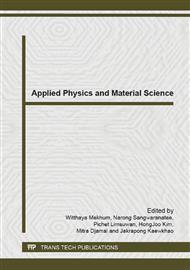p.440
p.444
p.448
p.455
p.459
p.463
p.467
p.471
p.479
The Effects of Temperature, Injection Current and Optical Feedback on the Frequency Stabilization of External Cavity Diode Laser
Abstract:
A frequency-stabilized diode laser is widely used for applications in laser cooling and high-resolution spectroscopy. In this work, the 780-nm external cavity diode laser was constructed and subsequently frequency-controlled by three parameters, i.e., temperature, injection current and optical feedback. The laser frequency was measured with respect to the 5S1/2 → 5P3/2 (D2-lines) transition of Rubidium, while the laser mode was characterized by a Fabry-Perot interferometer. The laser temperature was passively controlled to a single value between 20 ̊C and 25 ̊C while the injection current was investigated in combination with course and fine adjustments of optical feedback. Only data relevant to a single-mode laser operation was collected. It was found that as the current increased, the laser frequency shifted linearly with slopes approximately 0.5-0.8 GHz/mA. Optical feedback from the external cavity was tuned by the voltage applied to the piezoelectric transducer, yielding a linear frequency response of approximately 0.2 GHz/V. The measured parameters were rearranged to represent the island of stability of the laser, suggesting suitable conditions that yielded single-mode operation, at a desirable laser frequency. The results were important for a design of an active feedback, in order to further reduce the frequency linewidth and intensity noise of the laser.
Info:
Periodical:
Pages:
459-462
Citation:
Online since:
June 2014
Authors:
Price:
Сopyright:
© 2014 Trans Tech Publications Ltd. All Rights Reserved
Share:
Citation:


